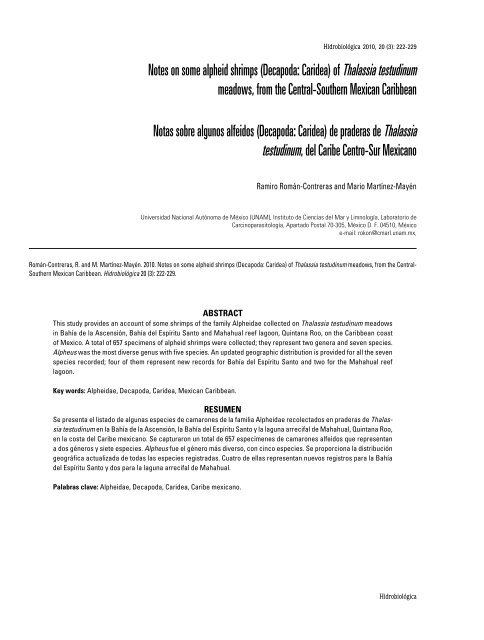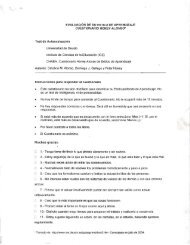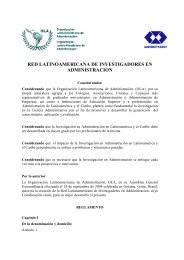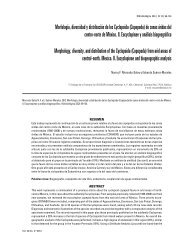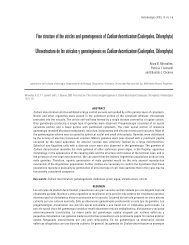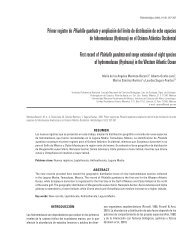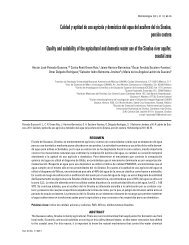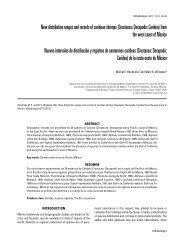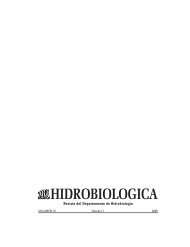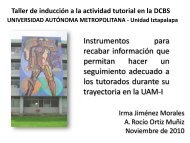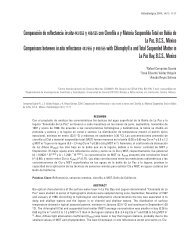Notes on some alpheid shrimps (Decapoda: Caridea) of Thalassia ...
Notes on some alpheid shrimps (Decapoda: Caridea) of Thalassia ...
Notes on some alpheid shrimps (Decapoda: Caridea) of Thalassia ...
Create successful ePaper yourself
Turn your PDF publications into a flip-book with our unique Google optimized e-Paper software.
222 Román-C<strong>on</strong>treras Hidrobiológica and 2010, Martínez-Mayén<br />
20 (3): 222-229<br />
<str<strong>on</strong>g>Notes</str<strong>on</strong>g> <strong>on</strong> <strong>some</strong> <strong>alpheid</strong> <strong>shrimps</strong> (<strong>Decapoda</strong>: <strong>Caridea</strong>) <strong>of</strong> <strong>Thalassia</strong> testudinum<br />
meadows, from the Central-Southern Mexican Caribbean<br />
Notas sobre algunos alfeidos (<strong>Decapoda</strong>: <strong>Caridea</strong>) de praderas de <strong>Thalassia</strong><br />
testudinum, del Caribe Centro-Sur Mexicano<br />
Ramiro Román-C<strong>on</strong>treras and Mario Martínez-Mayén<br />
Universidad Naci<strong>on</strong>al Autónoma de México (UNAM), Instituto de Ciencias del Mar y Limnología, Laboratorio de<br />
Carcinoparasitología, Apartado Postal 70-305, México D. F. 04510, México<br />
e-mail: rok<strong>on</strong>@cmarl.unam.mx,<br />
Román-C<strong>on</strong>treras, R. and M. Martínez-Mayén. 2010. <str<strong>on</strong>g>Notes</str<strong>on</strong>g> <strong>on</strong> <strong>some</strong> <strong>alpheid</strong> <strong>shrimps</strong> (<strong>Decapoda</strong>: <strong>Caridea</strong>) <strong>of</strong> <strong>Thalassia</strong> testudinum meadows, from the Central-<br />
Southern Mexican Caribbean. Hidrobiológica 20 (3): 222-229.<br />
ABSTRACT<br />
This study provides an account <strong>of</strong> <strong>some</strong> <strong>shrimps</strong> <strong>of</strong> the family Alpheidae collected <strong>on</strong> <strong>Thalassia</strong> testudinum meadows<br />
in Bahía de la Ascensión, Bahía del Espíritu Santo and Mahahual reef lago<strong>on</strong>, Quintana Roo, <strong>on</strong> the Caribbean coast<br />
<strong>of</strong> Mexico. A total <strong>of</strong> 657 specimens <strong>of</strong> <strong>alpheid</strong> <strong>shrimps</strong> were collected; they represent two genera and seven species.<br />
Alpheus was the most diverse genus with five species. An updated geographic distributi<strong>on</strong> is provided for all the seven<br />
species recorded; four <strong>of</strong> them represent new records for Bahía del Espíritu Santo and two for the Mahahual reef<br />
lago<strong>on</strong>.<br />
Key words: Alpheidae, <strong>Decapoda</strong>, <strong>Caridea</strong>, Mexican Caribbean.<br />
RESUMEN<br />
Se presenta el listado de algunas especies de camar<strong>on</strong>es de la familia Alpheidae recolectados en praderas de <strong>Thalassia</strong><br />
testudinum en la Bahía de la Ascensión, la Bahía del Espíritu Santo y la laguna arrecifal de Mahahual, Quintana Roo,<br />
en la costa del Caribe mexicano. Se capturar<strong>on</strong> un total de 657 especímenes de camar<strong>on</strong>es alfeidos que representan<br />
a dos géneros y siete especies. Alpheus fue el género más diverso, c<strong>on</strong> cinco especies. Se proporci<strong>on</strong>a la distribución<br />
geográfica actualizada de todas las especies registradas. Cuatro de ellas representan nuevos registros para la Bahía<br />
del Espíritu Santo y dos para la laguna arrecifal de Mahahual.<br />
Palabras clave: Alpheidae, <strong>Decapoda</strong>, <strong>Caridea</strong>, Caribe mexicano.<br />
Hidrobiológica
<str<strong>on</strong>g>Notes</str<strong>on</strong>g> <strong>on</strong> <strong>alpheid</strong>s from Mexican Caribbean 223<br />
INTRODUCTION<br />
Shrimps <strong>of</strong> the family Alpheidae, comm<strong>on</strong>ly known as snapping<br />
<strong>shrimps</strong>, are an abundant and ecologically diverse group <strong>of</strong> decapod<br />
crustaceans in most marine tropical and subtropical waters<br />
(Anker et al., 2006a), but are also distributed in cool-temperate<br />
(e.g., Anker & Komai, 2004), freshwater (De Grave et al. 2008),<br />
and brackish water habitats, such as mangroves and estuaries<br />
(Christ<strong>of</strong>fersen, 1984). Alpheids are distributed from the intertidal<br />
down to about a 1000 m in depth (see Anker et al., 2006a), but<br />
reach their greatest diversity in waters shallower than 50 m, particularly<br />
<strong>on</strong> coral reefs and adjacent habitats, e.g., sea-grass beds<br />
or sand flats with coral rubble. Many species are symbiotic with<br />
other organisms, such as sp<strong>on</strong>ges, anem<strong>on</strong>es, cnidarians, mollusks,<br />
echinoderms, annelids, fishes, and other crustaceans (Kim<br />
& Abele, 1988; Anker et al., 2006a).<br />
Several studies <strong>on</strong> the caridean fauna including the snapping<br />
<strong>shrimps</strong> have been carried out in the Caribbean regi<strong>on</strong>, most<br />
<strong>of</strong> them focused <strong>on</strong> their tax<strong>on</strong>omic and zoogeographic aspects<br />
(e.g., Armstr<strong>on</strong>g, 1949; Chace, 1972; Carvacho, 1979, 1982; Duffy,<br />
1996; Martínez-Iglesias et al., 1996, 1997; Vargas & Cortés, 1999;<br />
Anker, 2007; Anker et al., 2006b; Ríos & Duffy, 2007; Macd<strong>on</strong>ald et<br />
al., 2009); however, studies for the Mexican Caribbean are rather<br />
scarce, with Chace (1972) being the main reference presenting<br />
extensive tax<strong>on</strong>omic informati<strong>on</strong> <strong>on</strong> this group for the tropical<br />
western Atlantic, including the Yucatán Peninsula. Other important<br />
c<strong>on</strong>tributi<strong>on</strong>s are by Markham and D<strong>on</strong>ath-Hernández (1990)<br />
and Markham et al. (1990), who provided a synopsis <strong>of</strong> the shallow-water<br />
crustaceans <strong>of</strong> Quintana Roo, including several new<br />
records <strong>of</strong> <strong>alpheid</strong>s. Bri<strong>on</strong>es-Fourzán and Lozano-Álvarez (2002)<br />
reported <strong>some</strong> data about the <strong>alpheid</strong>s from Cozumel. The deep<br />
water caridean fauna was studied by Escobar-Bri<strong>on</strong>es and Villalobos-Hiriart<br />
(2003), who menti<strong>on</strong>ed three new records <strong>of</strong> snapping<br />
<strong>shrimps</strong> from the coast <strong>of</strong> Quintana Roo.<br />
800 µm in meadows <strong>of</strong> turtle-grass (T. testudinum) at a depth range<br />
<strong>of</strong> 0.4-1.0 m. Immediately after sampling, all the specimens were<br />
fixed in 10% formaldehyde and then transferred to 70% ethanol.<br />
The bottom was sand-mud with fragments <strong>of</strong> shells at Bahía de la<br />
Ascensión and Bahía del Espíritu Santo and sand in the Mahahual<br />
reef lago<strong>on</strong>. Additi<strong>on</strong>al metadata (currents, temperature, salinity,<br />
sediment type, and vegetati<strong>on</strong>) <strong>of</strong> these study areas can be found<br />
in Merino Ibarra (1986), Jordán-Dahlgren et al. (1994), Castellanos<br />
Osorio and Suárez-Morales (1997) and Suárez-Morales & Rivera-<br />
Arriaga (1998).<br />
The species treated here were arranged alphabetically;<br />
syn<strong>on</strong>ymies, material examined, geographic ranges, ecological<br />
notes, as well as new local records in the Mexican Caribbean<br />
are provided for each species. All specimens are deposited in the<br />
collecti<strong>on</strong> at the authors laboratory, in the Universidad Naci<strong>on</strong>al<br />
Autónoma de México (UNAM).<br />
RESULTS<br />
A total <strong>of</strong> 657 specimens from two genera and seven species<br />
were collected during the surveyed period. The genus Alpheus<br />
Fabricius, 1798 was the most diverse, with five species. Four species<br />
represent new records for the Bahía del Espíritu Santo, while<br />
two species are new records for Mahahual reef lago<strong>on</strong>.<br />
Order <strong>Decapoda</strong> Latreille, 1802<br />
Infraorder <strong>Caridea</strong> Dana, 1852<br />
During a study <strong>on</strong> the biology and ecology <strong>of</strong> bopyrid parasites<br />
<strong>of</strong> the caridean fauna based <strong>on</strong> recent field work in the<br />
Bahía de la Ascensión, Bahía del Espíritu Santo and the Mahahual<br />
reef lago<strong>on</strong>, <strong>alpheid</strong> <strong>shrimps</strong> were collected by trawling <strong>on</strong><br />
turtle-grass (<strong>Thalassia</strong> testudinum Banks ex König) meadows. In<br />
the present paper those <strong>shrimps</strong> are listed and <strong>some</strong> notes about<br />
them are provided.<br />
MATERIAL AND METHODS<br />
Field work was c<strong>on</strong>ducted at five stati<strong>on</strong>s in the Bahía de la Ascensión<br />
(19°30’-19°50’ N, 87°25’-87°50’ W), five in Bahía del Espíritu<br />
Santo (19°12’-19°25’ N, 87°41’-88°47’ W), and <strong>on</strong>e in Mahahual<br />
reef lago<strong>on</strong> (18°42.88’ N, 87°42.44’ W) al<strong>on</strong>g the central-southern<br />
coast <strong>of</strong> Quintana Roo, Mexico (Fig. 1), during July 1997, May and<br />
November 2001, May 2002, and January 2003. All specimens were<br />
collected with a Colman-Seagrove sledge net with a mesh size <strong>of</strong><br />
Figure 1. Central-southern coast <strong>of</strong> Quintana Roo, Mexico<br />
showing sites sampled (in black dots) (modified from Román-<br />
C<strong>on</strong>treras & Martínez-Mayén, 2010).<br />
Vol. 20 No. 3 • 2010
224 Román-C<strong>on</strong>treras and Martínez-Mayén<br />
Superfamily Alpheoidea Rafinesque, 1815<br />
Family Alpheidae Rafinesque, 1815<br />
Alpheus cf. armillatus H. Milne-Edwards, 1837<br />
Alpheus armillatus. Chace, 1972: 62; Felder & Chaney, 1979:<br />
25; Markham & McDermott, 1980: 1270; Rodríguez, 1980: 142, fig.<br />
40 h-k; Williams, 1984: 92, fig. 63; Martínez-Iglesias, 1986: 8, fig.<br />
3C; Markham et al., 1990: 420; Martínez-Guzmán & Hernández-<br />
Aguilera, 1993: 614; Hernández Aguilera et al., 1996: 28; Martínez-<br />
Iglesias et al., 1997: 403, fig. 4; Christ<strong>of</strong>fersen, 1998: 356; Bri<strong>on</strong>es-<br />
Fourzán & Lozano-Álvarez, 2002: 200; McClure, 2005: 129, fig. 6;<br />
Mossolin et al., 2006: 48.<br />
Alpheus cf. armillatus. Almeida et al., 2007: 11.<br />
Crang<strong>on</strong> armillatus. Schmitt, 1935: 142.<br />
Material examined: Bahía del Espíritu Santo, 2 specimens,<br />
November 2001.<br />
Distributi<strong>on</strong>: North Carolina (Williams, 1984) to nearby Port<br />
Aransas, Texas (Felder & Chaney, 1979); from Isla Lobos, Veracruz<br />
(Hernández Aguilera et al., 1996) and Isla Pérez, Arrecife Alacrán,<br />
Yucatán, Gulf <strong>of</strong> Mexico (Martínez-Guzmán & Hernández-Aguilera,<br />
1993), Isla Cozumel, Quintana Roo (Chace, 1972; Bri<strong>on</strong>es-<br />
Fourzán & Lozano-Álvarez, 2002), south to Santa Catarina, Brazil<br />
(Christ<strong>of</strong>fersen, 1998); West Indies from Bermuda (Markham &<br />
McDermott, 1980) to Tobago (Chace, 1972).<br />
Ecological notes: Under rocks and shells between interstices<br />
<strong>of</strong> coral (Chace, 1972); in sp<strong>on</strong>ges (Markham et al., 1990),<br />
and turtle-grass (McClure, 2005). Shallow-water to 14 m (Felder &<br />
Chaney, 1979), <strong>on</strong> calcareous bottom covered with T. testudinum,<br />
depth 0.5 m (present study).<br />
Local new records: Bahía del Espíritu Santo, Quintana Roo.<br />
Remarks: The material examined fits well with Chace’s (1972)<br />
key, and the figures and keys presented by Martínez-Iglesias et<br />
al. (1997) and McClure (2005) for the species. Alpheus armillatus<br />
is a large species complex that includes many cryptic species<br />
(Mathews & Anker, 2009). Those authors, based <strong>on</strong> molecular<br />
analyses <strong>of</strong> this species complex from the Caribbean Sea, Gulf <strong>of</strong><br />
Mexico, Florida, Brazil, and the tropical eastern Pacific, reported<br />
the presence <strong>of</strong> six clades broadly overlapped in their geographic<br />
distributi<strong>on</strong>, including 11 lineages in the western Atlantic and<br />
eight in the eastern Pacific, for a total number <strong>of</strong> at least 19 putative<br />
species c<strong>on</strong>tained in the A. armillatus species complex.<br />
Alpheus bouvieri A. Milne-Edwards, 1878<br />
Alpheus Edwarsii . Dana, 1852: 542 [not Audouin, 1826].<br />
Alpheus bouvieri. Christ<strong>of</strong>fersen, 1979: 303, figs. 2-5; Markham<br />
& McDermott, 1980: 1270; Abele & Kim, 1986: 18, 199, 214-215,<br />
figs. a-d; Markham et al., 1990: 421; Manning & Chace, 1990: 14;<br />
Hernández Aguilera et al., 1996: 30; Martínez-Iglesias et al., 1996:<br />
33; Martínez-Iglesias et al., 1997: 404, fig. 6; McClure, 2005: 133<br />
(part., not Fig. 8; see Anker et al., 2009).<br />
Not A. bouvieri. Christ<strong>of</strong>fersen, 1979: 303 (part., material from<br />
eastern Pacific; see Anker et al., 2009); Kim & Abele, 1988: 58, fig.<br />
24 (see Williams et al., 2001 and Anker et al., 2009).<br />
Material examined: Bahía de la Ascensión, <strong>on</strong>e specimen,<br />
May 2002.<br />
Distributi<strong>on</strong>: Eastern and southern Florida (Abele & Kim,<br />
1986); Gulf <strong>of</strong> Mexico: Veracruz and Campeche (Hernández Aguilera<br />
et al., 1996), Punta Xamach, Bahía de la Ascensión, Quintana<br />
Roo, Mexico (Markham et al., 1990); Bermuda (Markham & Mc-<br />
Dermott, 1980) and Cuba (Martínez-Iglesias et al., 1996) to Trinidad<br />
(Christ<strong>of</strong>fersen, 1979); south to Torres, Rio Grande do Sul, Brazil<br />
(Christ<strong>of</strong>fersen, 1979); eastern Atlantic from Cape Verde Islands<br />
and Senegal to Ilha de Sao Tomé and C<strong>on</strong>go (Christ<strong>of</strong>fersen,<br />
1979); south Atlantic: Ascensi<strong>on</strong> Island (Manning & Chace, 1990).<br />
Ecological notes: Am<strong>on</strong>g rocks, dead coral, <strong>some</strong>times in<br />
sp<strong>on</strong>ges (Christ<strong>of</strong>fersen, 1979), <strong>on</strong> zoanthids and coralline algae<br />
(Anker et al., 2009). Shallow subtidal to about 10 m depth (Anker<br />
et al., 2009), in beds <strong>of</strong> T. testudinum <strong>on</strong> sand, depth 0.6 m (present<br />
study).<br />
Remarks: The specimen examined agrees in general with<br />
Chace’s (1972) key, and the descripti<strong>on</strong> and figures by Christ<strong>of</strong>fersen<br />
(1979) and Anker et al. (2009) for A. bouvieri. This species<br />
was reported previously from the eastern Pacific and the Atlantic<br />
by Kim and Abele (1988). Anker et al. (2009) reviewed the Alpheus<br />
bouvieri species complex and restricted A. bouvieri to the<br />
Atlantic, while the eastern Pacific populati<strong>on</strong>s were assigned to<br />
Alpheus javieri Anker, Hurt and Knowlt<strong>on</strong>, 2009. This species is<br />
genetically distinct and with little differences in morphology and<br />
color pattern respect to A. bouvieri, such as a slightly narrower<br />
and deeper dorsal groove <strong>on</strong> the palm <strong>of</strong> the major chela, and the<br />
slightly shorter first carpal segment <strong>of</strong> the sec<strong>on</strong>d pereiopod, as<br />
well as tan or brown-colored spines <strong>on</strong> the propodus <strong>of</strong> third and<br />
fourth pereiopods, whereas in A. bouvieri such spines do not bear<br />
traces <strong>of</strong> color (Anker et al., 2009).<br />
A recently described species that could be c<strong>on</strong>fused with A.<br />
bouvieri in the western Atlantic is A. agilis Anker, Hurt & Knowlt<strong>on</strong>,<br />
2009, which is distributed <strong>on</strong>ly in Brazil and West Africa, distinguished<br />
from A. bouvieri by the presence <strong>of</strong> a spine <strong>on</strong> ischium<br />
<strong>of</strong> the third and fourth pereiopods (see Anker et al., 2009).<br />
Alpheus cf. floridanus Kingsley, 1878<br />
Alpheus floridanus. Chace, 1972: 65, figs. 17-20 (part.); Herbst<br />
et al., 1978: 991; Christ<strong>of</strong>fersen, 1979: 311, figs. 6-8; Markham &<br />
Hidrobiológica
<str<strong>on</strong>g>Notes</str<strong>on</strong>g> <strong>on</strong> <strong>alpheid</strong>s from Mexican Caribbean 225<br />
McDermott, 1980: 1270; Rodríguez, 1980: 144, fig. 41a-d; Martínez-<br />
Iglesias et al., 1997: 423, fig. 11; Christ<strong>of</strong>fersen, 1998: 358; Escobar-<br />
Bri<strong>on</strong>es & Villalobos-Hiriart, 2003: 108; McClure, 2005: 139 (part.,<br />
not fig. 13).<br />
Alpheus cf. floridanus. Almeida et al., 2007: 12.<br />
Crang<strong>on</strong> floridanus. Schmitt, 1935: 144; Pearse, 1950: 150.<br />
Material examined: Bahía de la Ascensión, 9 specimens,<br />
May 2002; 1 specimen, January 2003. Bahía del Espíritu Santo, 1<br />
specimen, May 2001. Mahahual reef lago<strong>on</strong>, 19 specimens, July<br />
1997.<br />
Distributi<strong>on</strong>: Western Atlantic from southeast <strong>of</strong> Cape Hatteras<br />
(35°01.5’N, 75°30.8’W), North Carolina (Herbst et al., 1978);<br />
Bermuda (Markham & McDermott, 1980); Dry Tortugas, Florida<br />
throughout the Gulf <strong>of</strong> Mexico (Christ<strong>of</strong>fersen, 1979, 1998); West<br />
Indies from Bahamas to Curaçao and B<strong>on</strong>aire (Christ<strong>of</strong>fersen,<br />
1979); Mexico: Bahía de la Ascensión, Quintana Roo (Chace, 1972)<br />
and north <strong>of</strong> Mahahual (Escobar-Bri<strong>on</strong>es & Villalobos-Hiriart,<br />
2003); south to Rio Grande do Sul, Brazil (Christ<strong>of</strong>fersen, 1998).<br />
Actually the records <strong>of</strong> A. floridanus from the eastern Atlantic and<br />
eastern Pacific refer to closely related species (Anker, 2001; Williams<br />
et al., 2001; Almeida et al., 2007).<br />
Ecological notes: Bottoms with calcareous algae, am<strong>on</strong>g<br />
hydrozoans and bryozoans (Christ<strong>of</strong>fersen, 1979); in s<strong>of</strong>t muddy<br />
sediments in mangroves, estuaries and coastal lago<strong>on</strong>s (Christ<strong>of</strong>fersen,<br />
1979, Martínez-Iglesias et al., 1997). Shallow-water to 240<br />
m (Escobar-Bri<strong>on</strong>es & Villalobos-Hiriart, 2003), <strong>on</strong> sand and mud<br />
bottoms with <strong>Thalassia</strong>, 0.5-1 m depth (present study).<br />
Local new records: Bahía del Espíritu Santo, Quintana Roo.<br />
Remarks: Alpheus floridanus form also a species complex,<br />
with four species in the western and eastern Atlantic and eastern<br />
Pacific (see Anker, 2001; Almeida et al., 2007). On the basis <strong>of</strong> a<br />
phylogenetic analysis, Bracken et al. (2007) menti<strong>on</strong>ed the existence<br />
<strong>of</strong> at least five different species within this complex when<br />
populati<strong>on</strong>s <strong>of</strong> the eastern Pacific, western Atlantic and Gulf <strong>of</strong><br />
Mexico were compared.<br />
Alpheus cf. packardii Kingsley, 1880<br />
Alpheus packardii. De Grave et al., 2006: 1421-1422.<br />
Crang<strong>on</strong> packardii. Schmitt, 1935: 144.<br />
Alpheus normanni Kingsley 1878 . Chace, 1972: 68; Christ<strong>of</strong>fersen,<br />
1979: 322; Williams, 1984: 97, fig. 66; Bauer, 1985: 152; Martínez-Guzmán<br />
& Hernández-Aguilera, 1993: 615; Martínez-Iglesias<br />
et al., 1997: 424, fig. 13; Christ<strong>of</strong>fersen, 1998: 359; Bri<strong>on</strong>es-Fourzán &<br />
Lozano-Álvarez, 2002: 200; McClure, 2005: 145, fig. 17, pl. 3, fig. A.<br />
Material examined: Bahía de la Ascensión, 40 specimens,<br />
May 2002; 1 specimen, January 2003. Bahía del Espíritu Santo, 3<br />
specimens, May 2001. Mahahual reef lago<strong>on</strong>, 573 specimens, July<br />
1997.<br />
Distributi<strong>on</strong>: Listed as A. normanni from Bermuda; around<br />
Cape Charles, Virginia (Williams, 1984) to Key West Florida and<br />
Texas (Christ<strong>of</strong>fersen, 1979); throughout the Gulf <strong>of</strong> Mexico to Isla<br />
Pérez, Arrecife Alacrán, Yucatán (Martínez-Guzmán & Hernández-Aguilera,<br />
1993); Isla Cozumel and Bahía de la Ascensión,<br />
Quintana Roo (Chace, 1972; Bri<strong>on</strong>es-Fourzán & Lozano-Álvarez,<br />
2002); to São Paulo, Brazil (Christ<strong>of</strong>fersen, 1998); West Indies from<br />
Bahamas (Christ<strong>of</strong>fersen, 1979) to Tobago (Chace, 1972).<br />
Ecological notes: Am<strong>on</strong>g coral reefs (Chace, 1972), <strong>on</strong> sand,<br />
mud, broken shells, algae and sp<strong>on</strong>ges (Christ<strong>of</strong>fersen, 1979) and<br />
meadows <strong>of</strong> T. testudinum (Bauer, 1985). Subtidal to 73 m (Chace,<br />
1972), collected <strong>on</strong> sand bottom covered with T. testudinum, depth<br />
0.5-1 m (present study).<br />
Local new records: Bahía del Espíritu Santo and Mahahual<br />
reef lago<strong>on</strong>, Quintana Roo.<br />
Remarks: Alpheus packardii form also is a species complex,<br />
with at least three probable cryptic species in the western Atlantic,<br />
and two in the eastern Pacific (Almeida et al., 2007). Chace<br />
(1937) c<strong>on</strong>sidered the eastern Pacific species A. normanni and<br />
the western Atlantic A. packardii as syn<strong>on</strong>yms. Kim and Abele<br />
(1988) compared specimens <strong>of</strong> A. normanni from the eastern Pacific<br />
with material from Florida and find that the male specimens<br />
from the eastern Pacific presented the minor chela <strong>of</strong> the first pereiopods<br />
more el<strong>on</strong>gated than the minor chela <strong>of</strong> male specimens<br />
from Florida; therefore, the eastern Pacific form was c<strong>on</strong>sidered<br />
by those authors as a different species from the Atlantic form and,<br />
according to Christ<strong>of</strong>fersen (1998) the western Atlantic specimens<br />
previously named as A. normanni must be attributed to A. packardii.<br />
The minor chela <strong>of</strong> 50 males examined in the present study<br />
ranges from 3.64 to 4.38 times as l<strong>on</strong>g as broad, compared to 5.8<br />
reported by Kim & Abele (1988) for A. normanni from the eastern<br />
Pacific, so, we c<strong>on</strong>cluded that the specimens examined bel<strong>on</strong>g to<br />
the A. packardii species complex.<br />
Alpheus viridari (Armstr<strong>on</strong>g, 1949)<br />
Crang<strong>on</strong> viridari. Armstr<strong>on</strong>g, 1949: 8-12, fig. 2.<br />
Alpheus viridari. Chace, 1972: 73; Carvacho, 1979: 455;<br />
Markham & McDermott, 1980: 1270; Martínez-Iglesias et al., 1997:<br />
424, fig. 17; Alvarez-León, 2003: 265; McClure, 2005: 155, fig. 23;<br />
Hernández-Ávila et al., 2007: 37.<br />
Material examined: Bahía de la Ascensión, 1 specimen, May<br />
2002. Mahahual reef lago<strong>on</strong>, 4 specimens, July 1997.<br />
Distributi<strong>on</strong>: Western Atlantic: Bermuda (Markham & McDermott,<br />
1980); Florida Keys to Trinidad and Curaçao (Chace, 1972);<br />
Isla Cozumel and Bahía de la Ascensión, Quintana Roo, Mexico<br />
Vol. 20 No. 3 • 2010
226 Román-C<strong>on</strong>treras and Martínez-Mayén<br />
(Chace, 1972); South Lago<strong>on</strong> <strong>of</strong> Chengue, Tayr<strong>on</strong>a, Colombia (Alvarez-León,<br />
2003); Isla Cubagua, Venezuela (Hernández-Ávila et<br />
al., 2007).<br />
Ecological notes: In dead coral (Chace, 1972), am<strong>on</strong>g mangrove<br />
roots (Martínez-Iglesias et al., 1997), muddy-sand bottom<br />
with meadows <strong>of</strong> Halodule wrightii (Aschers<strong>on</strong>), Halophila baill<strong>on</strong>is<br />
Aschers<strong>on</strong> ex Dickie; also reported <strong>on</strong> meadows <strong>of</strong> T. testudinum<br />
(see Álvarez-León, 2003). Intertidal to 20 m (Martínez-Iglesias<br />
et al., 1996), sand substrate with <strong>Thalassia</strong>, depth around 0.5 m<br />
(present study).<br />
Local new records: Mahahual reef lago<strong>on</strong>, Quintana Roo.<br />
Synalpheus apioceros Coutière, 1909<br />
Synalpheus apioceros. Coutière, 1909: 27, fig. 9; Chace, 1972:<br />
86; Carvacho, 1979: 463; Felder & Chaney, 1979: 25; Rodríguez,<br />
1980: 155; Abele & Kim, 1986: 19, 226-227, figs. i-k; Christ<strong>of</strong>fersen,<br />
1998: 362; Markham et al., 1990: 421; Wicksten, 2005: 32.<br />
Synalpheus cf. apioceros. Almeida et al., 2007: 14.<br />
Material examined: Bahía del Espíritu Santo, <strong>on</strong>e specimen,<br />
May 2001.<br />
Distributi<strong>on</strong>: Southern Florida (Chace, 1972); Stets<strong>on</strong> and<br />
West Flower Garden Bank (Wicksten, 2005); Seven and One-half<br />
Fathom Reef, Texas (Felder & Chaney, 1979); Isla Cozumel and Cayo<br />
Culebras, Bahía de la Ascensión, Quintana Roo, Mexico (Chace,<br />
1972); the Antilles, from Anegada Island to Tobago (Chace,1972);<br />
to Santa Catarina, Brazil (Christ<strong>of</strong>fersen, 1998).<br />
Ecological notes: Rubble fields near sea grass beds and mangroves<br />
(Carvacho, 1979); eroded rocks, mollusk shells, cavities <strong>of</strong><br />
sp<strong>on</strong>ges and tubes <strong>of</strong> polychaetes in 10-12 m (Felder & Chaney,<br />
1979), sand and rocky substrate with T. testudinum, depth less<br />
than 1 m (present study).<br />
Local new record: Bahía del Espíritu Santo, Quintana Roo.<br />
Remarks: The morphology <strong>of</strong> the specimen examined agrees<br />
well with the descripti<strong>on</strong> and figures provided by Coutière (1909),<br />
and Abele & Kim´s (1986) key and illustrati<strong>on</strong>s to S. apioceros. Almeida<br />
et al. (2007) stated that S. apioceros is a species complex<br />
with at least two species in the western Atlantic.<br />
Synalpheus fritzmuelleri Coutière, 1909<br />
Synalpheus fritzmülleri. Coutière, 1909: 35-37, fig. 18.<br />
Synalpheus fritzmuelleri. Chace, 1972: 92; Christ<strong>of</strong>fersen,<br />
1979: 341; Felder & Chaney, 1979: 25; Markham & McDermott,<br />
1980: 1270; Williams, 1984: 102, fig. 70; Manning & Chace, 1990:<br />
22; Markham et al., 1990: 422; Hernández Aguilera et al., 1996: 36;<br />
Martínez-Iglesias et al., 1996: 35; Christ<strong>of</strong>fersen, 1998: 362; Mc-<br />
Clure, 2005: 175, fig. 38; Wicksten, 2005: 32; Hermoso-Salazar &<br />
Solís-Weiss, 2010 : 65-68.<br />
Synalpheus cf. fritzmuelleri. Almeida et al., 2007: 14.<br />
Material examined: Bahía de la Ascensión, <strong>on</strong>e specimen,<br />
January 2003.<br />
Distributi<strong>on</strong>: Bermuda (Markham & McDermott, 1980); <strong>of</strong>f<br />
Cape Hatteras, North Carolina; west coast <strong>of</strong> Florida (Christ<strong>of</strong>fersen,<br />
1979); East Flower Garden Bank (Wicksten, 2005) and Seven<br />
and One-Half Fathom Reef, Texas (Felder & Chaney, 1979) to Isla<br />
Pérez, Alacrán Reef, Yucatán, Mexico (Hernández Aguilera et al.,<br />
1996); Puerto Morelos and Punta Xamach (Markham et al., 1990),<br />
Isla Cozumel, Bahía de la Ascensión and Bahía del Espíritu Santo,<br />
Quintana Roo, Mexico (Chace, 1972); Cuba (Martínez-Iglesias et<br />
al., 1996) to Tobago (Chace, 1972); south to Santa Catarina, Brazil<br />
(Christ<strong>of</strong>fersen, 1998); also in South Atlantic: Saint Helena (Christ<strong>of</strong>fersen,<br />
1979) and Ascensi<strong>on</strong> Island (Manning & Chace, 1990).<br />
Ecological notes: Sea grass flats with corals, Porites Link,<br />
1807, eroded coral, am<strong>on</strong>g roots <strong>of</strong> mangroves (Chace, 1972) and<br />
sp<strong>on</strong>ges (Markham et al., 1990); intertidal to 75 m (Christ<strong>of</strong>fersen,<br />
1979), am<strong>on</strong>g T. testudinum and sand bottom, depth 0.5 m (present<br />
study).<br />
Remarks: Previous records <strong>of</strong> S. fritzmuelleri from Tres<br />
Marías Archipelago (Isla María Madre) in the eastern Pacific actually<br />
bel<strong>on</strong>g to Synalpheus nobilii Coutière, 1909; therefore, according<br />
to Hermoso-Salazar and Solís-Weiss (2010), A. fritzmuelleri<br />
must be removed <strong>of</strong> the list from the eastern Pacific <strong>alpheid</strong>s.<br />
DISCUSSION<br />
As this study was limited to dredging in T. testudinum meadows, it<br />
is difficult to compare our results with other studies carried out in<br />
the Mexican Caribbean (Chace, 1972; Markham et al., 1990; Bri<strong>on</strong>es-Fourzán<br />
& Lozano-Álvarez, 2002; Escobar-Bri<strong>on</strong>es & Villalobos-Hiriart,<br />
2003) as they used various collecti<strong>on</strong> methods (i.e., by<br />
hand, corers, dredges, snorkeling and scuba diving) and sampled<br />
different habitats in their study area.<br />
The species recorded bel<strong>on</strong>g to the genera Alpheus and<br />
Synalpheus, both highly diverse and known to c<strong>on</strong>tain cryptic<br />
species that are difficult to distinguish based <strong>on</strong> morphologic<br />
characters (see Knowlt<strong>on</strong>, 1986 for a review <strong>of</strong> cryptic species;<br />
Knowlt<strong>on</strong>, 1993; Mathews & Anker, 2009). Hence, it is required<br />
to c<strong>on</strong>sider other data such as colour patterns (Knowlt<strong>on</strong>, 1986;<br />
Knowlt<strong>on</strong> & Mills, 1992; Anker, 2001) and the ecology and genetics<br />
<strong>of</strong> the species (Knowlt<strong>on</strong>, 1993; Williams et al., 2001; Anker et al.,<br />
2009; Mathews & Anker, 2009). According to Anker (2001), with<br />
the incorporati<strong>on</strong> <strong>of</strong> those data to the tax<strong>on</strong>omy, many species<br />
<strong>of</strong> <strong>alpheid</strong>s formerly c<strong>on</strong>sidered as widely distributed, have been<br />
recognized as species complexes.<br />
Hidrobiológica
<str<strong>on</strong>g>Notes</str<strong>on</strong>g> <strong>on</strong> <strong>alpheid</strong>s from Mexican Caribbean 227<br />
Of the species here treated, A. cf. armillatus, A. bouvieri, A.<br />
cf. floridanus, A. cf. packardii, and S. apioceros are currently recognized<br />
as part <strong>of</strong> species complexes (Almeida et al., 2007). Only<br />
the A. bouvieri species complex has been solved (Anker et al.,<br />
2009); the tax<strong>on</strong>omic review <strong>of</strong> the other menti<strong>on</strong>ed complexes<br />
is also urgent (see Anker et al., 2007). On the other hand, S. fritzmuelleri<br />
is c<strong>on</strong>sidered as a possible species complex (Almeida<br />
et al., 2007), whereas A. viridari may be a sister clade <strong>of</strong> the A.<br />
armillatus complex (Mathews & Anker, 2009).<br />
The occurrence <strong>of</strong> snapping <strong>shrimps</strong> in our samples is explained<br />
by the proximity to reefs in the studied areas, since many<br />
associated reef-species <strong>of</strong> crustaceans utilize the surrounding<br />
seagrass to live (Heck, 1977). The capture <strong>of</strong> species associated<br />
with other organisms such as S. fritzmuelleri (reported from<br />
sp<strong>on</strong>ges and am<strong>on</strong>g ascidians and gorg<strong>on</strong>ians, see Heck, 1977;<br />
Christ<strong>of</strong>fersen, 1979; Markham et al., 1990) may be attributed to<br />
the collecting activities that detached these <strong>shrimps</strong> from their<br />
hosts.<br />
The species recorded herein are restricted to tropical and<br />
subtropical waters (Christ<strong>of</strong>fersen, 1982; Manning & Chace, 1990;<br />
Markham et al., 1990) and according to previous geographic records,<br />
all those species are distributed in the western Atlantic,<br />
although A. bouvieri and S. fritzmuelleri also occur in the eastern<br />
Atlantic. At present, a detailed analysis <strong>of</strong> the distributi<strong>on</strong>al patterns<br />
in marine zoogeographic provinces <strong>of</strong> the species collected<br />
is not possible, as most bel<strong>on</strong>g to species complexes (Anker,<br />
2001; Almeida et al., 2007), and further changes are expected in<br />
their nomenclatural status and geographical distributi<strong>on</strong> (Anker<br />
et al., 2007). Therefore, a review <strong>of</strong> the <strong>alpheid</strong> cryptic fauna from<br />
the Mexican coasts using the multidisciplinary approaches menti<strong>on</strong>ed<br />
is recommended in order to determine the tax<strong>on</strong>omic status<br />
<strong>of</strong> the species herein reported.<br />
ACKNOWLEDGMENTS<br />
Our gratitude to A. Reda Deara (Estación El Carmen-ICMyL) for his<br />
support in the field; to J. Romero Rodríguez, M. A. Carballido Carranza,<br />
A. Sánchez Quiñ<strong>on</strong>es and V. Vega G<strong>on</strong>zález for processing<br />
partially the biological material, to the Dirección General de<br />
Vida Silvestre de la SEMARNAP and to the staff <strong>of</strong> the Reserva<br />
de la Biosfera de Sian Ka´an for providing facilities during the<br />
field work. Thanks to three an<strong>on</strong>ymous referees who helped to<br />
improve the first draft <strong>of</strong> the manuscript.<br />
REFERENCES<br />
Abele, L. G. & W. Kim. 1986. An illustrated guide to the marine decapod<br />
crustaceans <strong>of</strong> Florida. Technical Series <strong>of</strong> the State <strong>of</strong> Florida, Department<br />
<strong>of</strong> Envir<strong>on</strong>mental Regulati<strong>on</strong>. Vol. 8, part 1. 326 p.<br />
Almeida, A. O., M. C. Guerrazzi & P. A. Coelho. 2007. Stomatopod and decapod<br />
crustaceans from Camamu Bay, state <strong>of</strong> Bahia, Brazil. Zootaxa<br />
1553: 1-45.<br />
Álvarez-León, R. 2003. New records <strong>of</strong> crustaceans from Tayr<strong>on</strong>a Natural<br />
Nati<strong>on</strong>al Park, Colombian Caribbean. Revista de Biología Tropical<br />
51: 265.<br />
Anker, A. 2001. Two new species <strong>of</strong> snapping <strong>shrimps</strong> from the Indo-Pacific,<br />
with remarks <strong>on</strong> colour patterns and sibling species in Alpheidae<br />
(Crustacea: <strong>Caridea</strong>). The Raffles Bulletin <strong>of</strong> Zoology 49: 57-72.<br />
Anker, A. 2007. Alpheus zimmermani sp. nov., a new colorful snapping<br />
shrimp (Crustacea: <strong>Decapoda</strong>) from the Caribbean Sea. Cahiers de<br />
Biologie Marine 48: 241-247.<br />
Anker, A., S. T. Ahy<strong>on</strong>g, P. Y. Noël & A. R. Palmer. 2006a. Morphological<br />
phylogeny <strong>of</strong> <strong>alpheid</strong> <strong>shrimps</strong>: parallel preadaptati<strong>on</strong> and the origin<br />
<strong>of</strong> a key morphological innovati<strong>on</strong>, the snapping claw. Evoluti<strong>on</strong> 60:<br />
2505-2528.<br />
Anker, A., J. A. Vera Caripe & C. Lira. 2006b. Descripti<strong>on</strong> <strong>of</strong> a new species<br />
<strong>of</strong> commensal <strong>alpheid</strong> shrimp (Crustacea, <strong>Decapoda</strong>) from the<br />
southern Caribbean Sea. Zoosystema 28: 683-702.<br />
Anker, A., C. Hurt & N. Knowlt<strong>on</strong>. 2007. Three transisthmian snapping<br />
<strong>shrimps</strong> (Crustacea: <strong>Decapoda</strong>: Alpheidae: Alpheus) associated<br />
with innkeeper worms (Echiura: Thalassematidae) in Panama. Zootaxa<br />
1626: 1-23.<br />
Anker, A., C. Hurt & N. Knowlt<strong>on</strong>. 2009. Descripti<strong>on</strong> <strong>of</strong> cryptic taxa within<br />
the Alpheus bouvieri A. Milne-Edwards, 1878 and A. hebes Kim and<br />
Abele, 1988 species complexes (Crustacea: <strong>Decapoda</strong>: Alpheidae).<br />
Zootaxa 2153: 1-23.<br />
Anker, A. & T. Komai. 2004. Descripti<strong>on</strong>s <strong>of</strong> two new species <strong>of</strong> <strong>alpheid</strong><br />
<strong>shrimps</strong> from Japan and Australia, with notes <strong>on</strong> tax<strong>on</strong>omy <strong>of</strong> Automate<br />
De Man, Cor<strong>on</strong>alpheus Wicksten and Bermudacaris Anker<br />
and Iliffe (Crustacea: <strong>Decapoda</strong>: <strong>Caridea</strong>). Journal <strong>of</strong> Natural History<br />
38: 1895-1914.<br />
Armstr<strong>on</strong>g, J. C. 1949. New <strong>Caridea</strong> from the Dominican Republic. American<br />
Museum Novitates 1410: 1-27.<br />
Bauer, R. T. 1985. Diel and seas<strong>on</strong>al variati<strong>on</strong> in species compositi<strong>on</strong> and<br />
abundance <strong>of</strong> caridean <strong>shrimps</strong> (Crustacea, <strong>Decapoda</strong>) from seagrass<br />
meadows <strong>on</strong> the north coast <strong>of</strong> Puerto Rico. Bulletin <strong>of</strong> Marine<br />
Science 36: 150-162.<br />
Bracken, H. D., R. Robles & D. L. Felder. 2007. Cryptic diversity within the<br />
genus Alpheus from the Gulf <strong>of</strong> Mexico and adjacent waters (<strong>Decapoda</strong>:<br />
<strong>Caridea</strong>: Alpheidae). In: The Crustacean Society Mid-Year<br />
Meeting. Program and Abstracts. Coquimbo, Chile. p. 41 (Unpublished).<br />
Bri<strong>on</strong>es-Fourzán, P. & E. Lozano-Álvarez. 2002. Shallow-water benthic decapod<br />
crustaceans <strong>of</strong> Chankanaab Park, Cozumel Island, México. In:<br />
Escobar-Bri<strong>on</strong>es, E. & F. Álvarez (Eds.). Modern Approaches to the<br />
Study <strong>of</strong> Crustaceans. Kluwer, Amsterdam, pp. 197-204.<br />
Carvacho, A. 1979. Les crevettes carides de la mangrove guadaloupéenne.<br />
Bulletin du Muséum Nati<strong>on</strong>al d’Histoire Naturelle, Paris, 4e<br />
séries, secti<strong>on</strong> A, 2: 445-470.<br />
Vol. 20 No. 3 • 2010
228 Román-C<strong>on</strong>treras and Martínez-Mayén<br />
Carvacho, A. 1982. Sur une petite collecti<strong>on</strong> de crevettes de la Martinique.<br />
Caribbean Journal <strong>of</strong> Science 17: 15-20.<br />
Castellanos Osorio, I. A. & E. Suárez-Morales. 1997. Observaci<strong>on</strong>es sobre<br />
el zooplanct<strong>on</strong> de la z<strong>on</strong>a arrecifal de Mahahual, Quintana Roo (Mar<br />
Caribe Mexicano). Anales del Instituto de Biología, Universidad Naci<strong>on</strong>al<br />
Autónoma de México, Serie Zoología 68: 237-252.<br />
Chace, F. A., Jr. 1937. The Templet<strong>on</strong> Crocker Expediti<strong>on</strong>. VII. <strong>Caridea</strong>n<br />
decapod crustacea from the Gulf <strong>of</strong> California and the west coast <strong>of</strong><br />
Lower California. Zoologica, New York 22: 109-138.<br />
Chace, F. A., Jr. 1972. The <strong>shrimps</strong> <strong>of</strong> the Smiths<strong>on</strong>ian-Bredin Caribbean<br />
Expediti<strong>on</strong>s with summary <strong>of</strong> the West Indian shallow-water species<br />
(Crustacea: <strong>Decapoda</strong>: Natantia). Smiths<strong>on</strong>ian C<strong>on</strong>tributi<strong>on</strong>s to<br />
Zoology 98: 1-179.<br />
Christ<strong>of</strong>fersen, M. L. 1979. Decapod Crustacea: Alpheoidea. Campagne<br />
de la Calypso au large des côtes Atlantiques de l’Amérique du Sud<br />
(1961-1962). I. Résultats scientifiques des campagnes de la Calypso.<br />
Fascicule XI. Annales de l’Institut Océanographique M<strong>on</strong>aco (Suppl.)<br />
55: 297-377.<br />
Christ<strong>of</strong>fersen, M. L. 1982. Distributi<strong>on</strong> <strong>of</strong> warm water alpheoid shrimp<br />
(Crustacea, <strong>Caridea</strong>) <strong>on</strong> the c<strong>on</strong>tinental shelf <strong>of</strong> eastern South America<br />
between 23 and 35° lat. S. Boletim do Instituto Oceanográfico,<br />
São Paulo 31: 93-112.<br />
Christ<strong>of</strong>fersen, M. L. 1984. The western Atlantic snapping <strong>shrimps</strong> related<br />
to Alpheus heterochaelis Say (Crustacea, <strong>Caridea</strong>), with the descripti<strong>on</strong><br />
<strong>of</strong> a new species. Papéis Avulsos de Zoologia, São Paulo 35:<br />
189-208.<br />
Christ<strong>of</strong>fersen, M. L. 1998. Malacostraca-Eucarida. <strong>Caridea</strong>. Crang<strong>on</strong>oidea<br />
and Alpheoidea (except Glyphocrang<strong>on</strong>idae and Crang<strong>on</strong>idae).<br />
In: Young, P.S. (Ed.), Catalogue <strong>of</strong> Crustacea <strong>of</strong> Brazil. (Serie Livros<br />
n. 6), Museu Naci<strong>on</strong>al, Rio de Janeiro, pp. 351-372.<br />
Coutière, H. 1909. The American species <strong>of</strong> snapping <strong>shrimps</strong> <strong>of</strong> the genus<br />
Synalpheus. Proceedings <strong>of</strong> the United States Nati<strong>on</strong>al Museum 36:<br />
1-93.<br />
Dana, J. D. 1852. Crustacea, Part I. United States Exploring Expediti<strong>on</strong>,<br />
during the years 1838, 1839, 1840, 1841, 1842, under the command <strong>of</strong><br />
Charles Wilkes, U. S. N., Vol. 13. Philadelphia. 685 p.<br />
De Grave, S., Y. Cai & A. Anker. 2008. Global diversity <strong>of</strong> <strong>shrimps</strong> (Crustacea:<br />
<strong>Decapoda</strong>: <strong>Caridea</strong>) in freshwater. Hydrobiologia 595: 287-293.<br />
De Grave, S., D. Livingst<strong>on</strong> & M. R. Speight. 2006. Diel variati<strong>on</strong> in sea grass<br />
dwelling shrimp: when to sample at night Journal <strong>of</strong> the Marine<br />
Biological Associati<strong>on</strong> <strong>of</strong> the United Kingdom 86: 1421-1422.<br />
Duffy, J. E. 1996. Synalpheus regalis, new species, a sp<strong>on</strong>ge-dwelling<br />
shrimp from the Belize barrier reef, with comments <strong>on</strong> host specificity<br />
in Synalpheus. Journal <strong>of</strong> Crustacean Biology 16: 564-573.<br />
Escobar-Bri<strong>on</strong>es, E. & J. L. Villalobos-Hiriart. 2003. Deep-water caridean<br />
<strong>shrimps</strong> (Crustacea: <strong>Decapoda</strong>) from Banco Chinchorro and adjacent<br />
areas in the northern Caribbean. Bulletin <strong>of</strong> Marine Science 73:<br />
99-122.<br />
Felder, D. L. & A. H. Chaney. 1979. Decapod crustacean fauna <strong>of</strong> Seven<br />
and One-Half Fathom Reef, Texas: species compositi<strong>on</strong>, abundance,<br />
and species diversity. C<strong>on</strong>tributi<strong>on</strong>s in Marine Science 22: 1-29.<br />
Heck, K. L., Jr. 1977. Comparative species richness, compositi<strong>on</strong>, and<br />
abundance <strong>of</strong> invertebrates in Caribbean seagrass (<strong>Thalassia</strong> testudinum)<br />
meadows (Panama). Marine Biology 41: 335-348.<br />
Herbst, G. N., A. B. Williams & B. B. Boothe, Jr. 1978. Reassessment <strong>of</strong><br />
northern geographic limits for decapod crustacean species in the<br />
Carolinian Province, USA; <strong>some</strong> major range extensi<strong>on</strong>s itemized.<br />
Proceedings <strong>of</strong> the Biological Society <strong>of</strong> Washingt<strong>on</strong> 91: 989-998.<br />
Hermoso-Salazar, M. & V. Solís-Weiss. 2010. Distributi<strong>on</strong> and morphological<br />
variati<strong>on</strong> <strong>of</strong> Synalpheus superus Abele and Kim, 1989 and notes<br />
<strong>on</strong> the distributi<strong>on</strong> <strong>of</strong> S. fritzmuellri Coutière, 1909 (<strong>Decapoda</strong>: <strong>Caridea</strong>:<br />
Alpheidae). Zootaxa 2505: 65-68.<br />
Hernández Aguilera, J. L., R. E. Toral Almazán & J. A. Ruiz Nuño. 1996.<br />
Especies catalogadas de crustáceos estomatópodos y decápodos<br />
para el Golfo de México, Río Bravo, Tamps. a Puerto Progreso, Yuc.<br />
Dirección General de Oceanografía Naval, Secretaria de Marina y<br />
Comisión Naci<strong>on</strong>al para el C<strong>on</strong>ocimiento y Uso de la Biodiversidad,<br />
México. 132 p.<br />
Hernández-Ávila, I., A. Gómez, C. Lira & L. Galindo. 2007. Benthic decapod<br />
crustaceans (Crustacea: <strong>Decapoda</strong>) <strong>of</strong> Cubagua Island, Venezuela.<br />
Zootaxa 1557: 33-45.<br />
Jordán-Dahlgren, E., E. Martín-Chávez, M. Sánchez-Segura & A. G<strong>on</strong>zález<br />
de la Parra. 1994. The Sian Ka’an Biosphere Reserve coral reef system,<br />
Yucatán Peninsula, Mexico. Atoll Research Bulletin 423: 1-31.<br />
Kim, W. & L. G. Abele. 1988. The snapping shrimp genus Alpheus from the<br />
Eastern Pacific (<strong>Decapoda</strong>: <strong>Caridea</strong>: Alpheidae). Smiths<strong>on</strong>ian C<strong>on</strong>tributi<strong>on</strong>s<br />
to Zoology 454: 1-119.<br />
Knowlt<strong>on</strong>, N. 1986. Cryptic and sibling species am<strong>on</strong>g the decapod crustacea.<br />
Journal <strong>of</strong> Crustacean Biology 6: 356-363.<br />
Knowlt<strong>on</strong>, N. 1993. Sibling species in the sea. Annual Review <strong>of</strong> Ecology<br />
and Systematics 24: 189-216.<br />
Knowlt<strong>on</strong>, N. & De E. K. Mills. 1992. The systematic importance <strong>of</strong> color<br />
and color pattern: evidence for complexes <strong>of</strong> sibling species <strong>of</strong><br />
snapping shrimp (<strong>Caridea</strong>: Alpheidae: Alpheus) from the Caribbean<br />
and Pacific coasts <strong>of</strong> Panama. Proceedings <strong>of</strong> the San Diego Society<br />
<strong>of</strong> Natural History 18: 1-5.<br />
Macd<strong>on</strong>ald III, K. S., K. Hultgren & J. E. Duffy. 2009. The sp<strong>on</strong>ge-dwelling<br />
snapping <strong>shrimps</strong> (Crustacea, <strong>Decapoda</strong>, Alpheidae, Synalpheus)<br />
<strong>of</strong> Discovery Bay, Jamaica, with descripti<strong>on</strong>s <strong>of</strong> four new species.<br />
Zootaxa 2199: 1-57.<br />
Manning, R. B. & F. A. Chace, Jr. 1990. Decapod and stomatopod crustacea<br />
from Ascensi<strong>on</strong> Island, South Atlantic Ocean. Smiths<strong>on</strong>ian<br />
C<strong>on</strong>tributi<strong>on</strong>s to Zoology 503: 1-91.<br />
Markham, J. C. & F. E. D<strong>on</strong>ath-Hernández. 1990. Crustacea <strong>of</strong> Sian Ka’an,<br />
including orders Nectiopoda, Stomatopoda, Thermosbaena, Mysi-<br />
Hidrobiológica
<str<strong>on</strong>g>Notes</str<strong>on</strong>g> <strong>on</strong> <strong>alpheid</strong>s from Mexican Caribbean 229<br />
dacea, Cumacea, Tanaidacea, Isopoda and <strong>Decapoda</strong>. In: Navarro,<br />
L. D. & J. G. Robins<strong>on</strong> (Eds.). Diversidad Biológica en la Reserva de<br />
la Biósfera de Sian Ka’an Quintana Roo, México. Vol. 1. Centro de<br />
Investigaci<strong>on</strong>es de Quintana Roo, México & Program <strong>of</strong> Studies in<br />
Tropical C<strong>on</strong>servati<strong>on</strong>, University <strong>of</strong> Florida, pp. 239-256.<br />
Markham, J. C., F. E. D<strong>on</strong>ath-Hernández, J. L. Villalobos-Hiriart & A. C.<br />
Díaz-Barriga. 1990. <str<strong>on</strong>g>Notes</str<strong>on</strong>g> <strong>on</strong> the shallow-water marine Crustacea <strong>of</strong><br />
the Caribbean Coast <strong>of</strong> Quintana Roo, Mexico. Anales del Instituto<br />
de Biología, Universidad Naci<strong>on</strong>al Autónoma de México, Serie Zoología<br />
61: 405-446.<br />
Markham, J. C. & J. J. McDermott. 1980. A tabulati<strong>on</strong> <strong>of</strong> the Crustacea<br />
<strong>Decapoda</strong> <strong>of</strong> Bermuda. Proceedings <strong>of</strong> the Biological Society <strong>of</strong><br />
Washingt<strong>on</strong> 93: 1266-1276.<br />
Martínez-Guzmán, L. A. & J. L. Hernández-Aguilera. 1993. Crustáceos<br />
estomatópodos y decápodos del Arrecife Alacrán, Yucatán. In:<br />
Salazar-Vallejo, S. I. & N. E. G<strong>on</strong>zález (Eds.). Biodiversidad Marina y<br />
Costera de México. Comisión Naci<strong>on</strong>al de la Biodiversidad y CIQRO,<br />
México, pp. 609-629.<br />
Martínez-Iglesias, J. C. 1986. Los crustáceos decápodos del Golfo de Batabanó.<br />
<strong>Caridea</strong> y Penaeidea. Poeyana 321: 1-37.<br />
Martínez-Iglesias, J. C., A. Carvacho & R. Ríos. 1996. Catálogo de los<br />
carídeos marinos (Crustacea, <strong>Decapoda</strong>, <strong>Caridea</strong>) de las aguas<br />
<strong>some</strong>ras de Cuba. Avicennia 4/5: 27-40.<br />
Martínez-Iglesias, J. C., R. Ríos & A. Carvacho. 1997. Las especies del género<br />
Alpheus (<strong>Decapoda</strong>: Alpheidae) de Cuba. Revista de Biología<br />
Tropical 44/45: 401-429.<br />
Mathews, L. M. & A. Anker. 2009. Molecular phylogeny reveals extensive<br />
ancient and <strong>on</strong>going radiati<strong>on</strong>s in a snapping shrimp species complex<br />
(Crustacea, Alpheidae, Alpheus armillatus). Molecular Phylogenetics<br />
and Evoluti<strong>on</strong> 50: 268-281.<br />
McClure, M. R. 2005. Snapping <strong>shrimps</strong>. In: Hernández Aguilera, J. L., J.<br />
A. Ruiz Nuño, R. E. Toral Almazán & V. Arenas Fuentes (Eds.). Camar<strong>on</strong>es,<br />
langostas y cangrejos de la costa este de México. Volumen 1.<br />
Estudio y C<strong>on</strong>servación de la Naturaleza y Comisión Naci<strong>on</strong>al para<br />
el C<strong>on</strong>ocimiento y Uso de la Biodiversidad, Mexico, pp. 119-201.<br />
Merino-Ibarra, M. 1986. Aspectos de la circulación costera superficial<br />
del Caribe Mexicano c<strong>on</strong> base en observaci<strong>on</strong>es utilizando tarjetas<br />
de deriva. Anales del Instituto de Ciencias del Mar y Limnología, Universidad<br />
Naci<strong>on</strong>al Autónoma de México 13: 31-46.<br />
Mossolin, E. C., R. M. Shimizu & S. L. S. Bueno. 2006. Populati<strong>on</strong> structure<br />
<strong>of</strong> Alpheus armillatus (<strong>Decapoda</strong>, Alpheidae) in São Sebastião<br />
and Ilhabela, southeastern Brazil. Journal <strong>of</strong> Crustacean Biology 26:<br />
48-54.<br />
Pearse, A. S. 1950. <str<strong>on</strong>g>Notes</str<strong>on</strong>g> <strong>on</strong> the inhabitants <strong>of</strong> certain sp<strong>on</strong>ges at Bimini.<br />
Ecology 3: 149-151.<br />
Ríos, R. & J. E. Duffy. 2007. A review <strong>of</strong> the sp<strong>on</strong>ge-dwelling snapping<br />
shrimp from the Carrie Bow Cay, Belize, with descripti<strong>on</strong> <strong>of</strong> Zuzalpheus,<br />
new genus, and six new species (Crustacea: <strong>Decapoda</strong>: Alpheidae).<br />
Zootaxa 1602: 1-89.<br />
Rodríguez, G. 1980. Los crustáceos decápodos de Venezuela. Instituto<br />
Venezolano de Investigaci<strong>on</strong>es Científicas, Caracas. 494 p.<br />
Román-C<strong>on</strong>treras, R. & M. Martínez-Mayén. 2010. <str<strong>on</strong>g>Notes</str<strong>on</strong>g> <strong>on</strong> marine shallow-water<br />
carideans (Pasiphaeidae, Gnathophyllidae, and Processidae)<br />
from Quintana Roo, Mexico. Crustaceana 83: 957-970.<br />
Schmitt, W. L. 1935. Crustacea Macrura and Anomura <strong>of</strong> Porto Rico and<br />
the Virgin Islands. Scientific Survey <strong>of</strong> Porto Rico and the Virgin Islands.<br />
New York Academy <strong>of</strong> Sciences 15: 125-227.<br />
Suárez-Morales, E. & E. Rivera Arriaga. 1998. Zooplanct<strong>on</strong> e hidrodinámica<br />
en z<strong>on</strong>as litorales y arrecifales de Quintana Roo, México. Hidrobiológica<br />
8: 19-32.<br />
Vargas, R, & J. Cortés. 1999. Biodiversidad marina de Costa Rica: Crustacea:<br />
<strong>Decapoda</strong>: (Penaeoidea, Sergestoidea, Stenopodidea, <strong>Caridea</strong>,<br />
Thalassinidea, Palinura) del Caribe. Revista de Biología Tropical 47:<br />
877-885.<br />
Wicksten, M. K. 2005. Decapod crustaceans <strong>of</strong> the Flower Gardens Banks<br />
Nati<strong>on</strong>al Marine Sanctuary. Gulf <strong>of</strong> Mexico Science 23: 30-37.<br />
Williams, A. B. 1984. Shrimps, lobsters, and crabs <strong>of</strong> the Atlantic coast <strong>of</strong><br />
the Eastern United States, Maine to Florida. Smiths<strong>on</strong>ian Instituti<strong>on</strong><br />
Press, Washingt<strong>on</strong>, D. C. 550 p.<br />
Williams, S. T., N. Knowlt<strong>on</strong>, L. A. Weigt & J. A. Jara. 2001. Evidence<br />
for three major clades within the snapping shrimp genus Alpheus<br />
inferred from nuclear and mitoch<strong>on</strong>drial gene sequence data. Molecular<br />
Phylogenetics and Evoluti<strong>on</strong> 20: 375-389.<br />
Recibido: 03 de febrero 2010.<br />
Aceptado: 22 de noviembre 2010.<br />
Vol. 20 No. 3 • 2010


